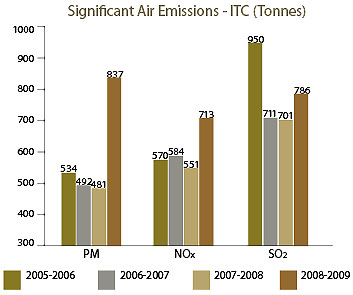Significant Air Emissions
 We made continous improvements in this area and ensured that emission levels not only comply with statutory norms but also achieve international benchmarks. This was achieved through adoption of cleaner technology/fuel and state-of-the-art pollution control equipment such as bagfilters/scrubber. We made continous improvements in this area and ensured that emission levels not only comply with statutory norms but also achieve international benchmarks. This was achieved through adoption of cleaner technology/fuel and state-of-the-art pollution control equipment such as bagfilters/scrubber.
All our units monitor significant air emission parameters such as Particulate Matter (PM), Nitrogen Oxides (NOx) and Sulphur Dioxide (SO2) on a regular basis.
The increase in total emissions in 2008-09 is mainly due to significant growth in all ITC businesses together with installation of the new pulp mill, at Bhadrachalam, commissioning of a new paper machine (thereby significantly enlarging the proportion of paper in the product mix - paper requiring almost 3 times the pulp needed to manufacture the same amount of paperboards) and a large number of project activities.
 However, all units made significant efforts to reduce specific emission levels. The Cigarette business has achieved significant reduction in specific PM, NOx and SO2 emissions in the last three years. However, all units made significant efforts to reduce specific emission levels. The Cigarette business has achieved significant reduction in specific PM, NOx and SO2 emissions in the last three years.
The leaf threshing business reduced the specific Particulates emissions from 0.62 kg to 0.50 kg per tonne of leaf processed (a reduction of 19.3%). The specific NOx and SO2 emissions have also been brought down by 37.7% and 56.6% respectively from the previous year. |

